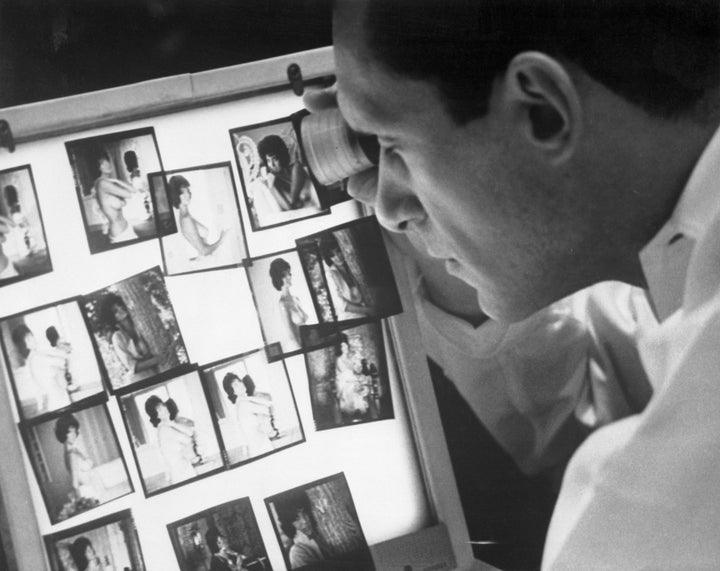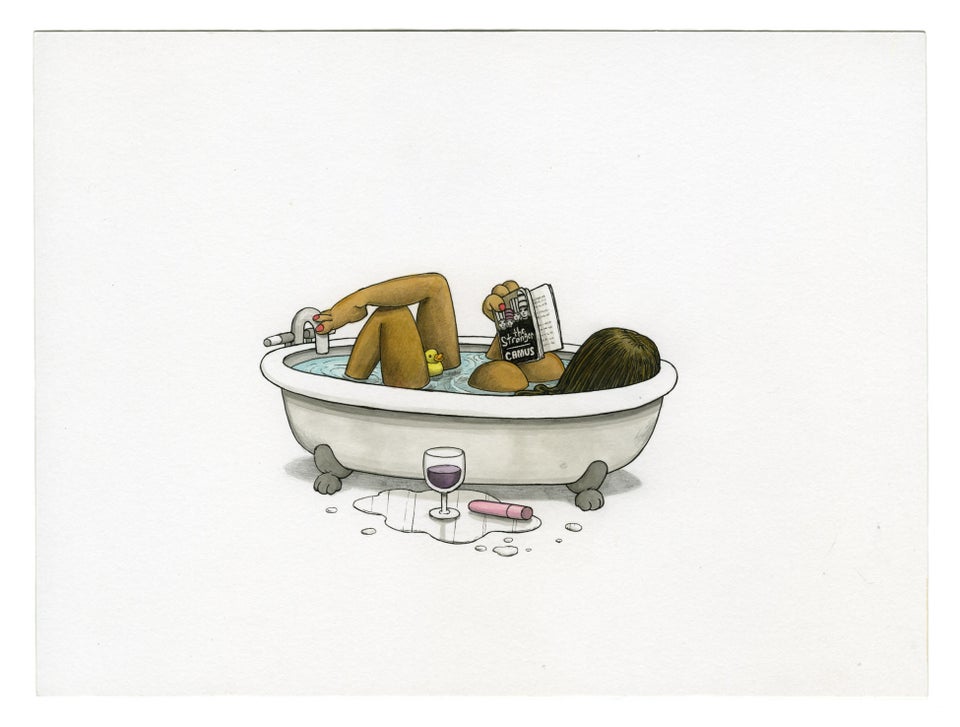For decades, Hugh Hefner’s Playboy was the magazine men could read equally for the articles or the explicit nude photos ― substance and fun all in one glossy package. It published Chuck Palahniuk, Joyce Carol Oates and Pamela Anderson.
This high-low combination was simultaneously unique to Playboy and an encapsulation of what men’s magazines could be: A place for men to be uninhibitedly men, and a place for serious, essential journalism and fiction. Where women’s magazines were typically offering an accessible blend of easy-reading journalism and lifestyle coverage, Playboy was drawing men in with porn and then showing them top-shelf writing. Decades later, it’s clear that Playboy’s brand also ended up solidifying the still-pervasive assumption that men love avant-garde literature and hard-nosed reporting, while women love baking muffins.
Playboy was meant to capture every aspect of a modern man’s fancy. Men liked science fiction, so there would be science fiction; men liked music, so there would be writing on music; oh, and men liked naked women, so there would be naked women, too.

In the process, his champions have long argued, Hefner dismantled Puritanical attitudes toward sex, contributed to the sexual liberation of both men and women, and arose as a sort of feminist icon (despite the protests of second-wave feminists like Gloria Steinem). But while the higher-brow culture of Playboy helped legitimize sexual titillation in a buttoned-up world, it also created a new space for literary life ― one with no particular interest in welcoming female readers.
Playboy’s frankly sexual content set it apart from other mags of the day, and accordingly defined its reputation. As Playboy quickly came to stand for nude centerfolds and orgiastic parties featuring cotton-tailed hotties in corsets, there’s always been a strong side-eye directed at men who claim, defensively, to read the magazine “for the articles.” On the other hand, a lot of the articles were worth reading. Critics have celebrated the magazine’s sex positivity, but also its commitment to publishing investigative reporting, interviews with political figures and literary fiction.
Its fiction, in particular, was noteworthy; over the years, the magazine published short stories by writers like Ursula K. Le Guin, David Foster Wallace and Joseph Heller. Playboy was willing to showcase edgy, subversive and graphic stories that might struggle to find publishers elsewhere. And all the while, sprinkled between the stories and articles, there were naked women.
Playboy’s longtime fiction editor, Alice K. Turner, once recalled, in an interview, Hefner’s speech at an anniversary celebration. To the past models invited to the event, he said, “I want you to know that I owe it all to you. Without you, I would have had nothing but a ... literary magazine.” And that’s hardly what he was going for. In a 1985 Interview Magazine feature, he was asked about his favorite book. “My favorite movie would be very easy to talk about,” he replied, adding, “I have always been very visually oriented.”
To Hefner, the magazine’s sexual politics, racy design and buxom blondes were the heart of the matter; the quality writing was window dressing, filling out a vision of what a forward-thinking gentleman might read.

Playboy’s intellectualism elevated its pinup mission, but by mixing the two together, the magazine also doubled down on the already-present perception of literary fiction and serious journalism as predominantly the domains of men. Though women’s magazines have long mixed substantive reporting in amongst makeup tips and dating columns, their reputations have suffered over recent decades compared to men’s magazines, which traded on the id-level appeal of sex and burnished their brands with flashy investments in prestige writers and artists ― none more so than Playboy. We still express surprise when Teen Vogue or Glamour openly show interest in politics; for men’s magazines like Playboy and Esquire, the mixture of high and low is generally expected.
Women weren’t explicitly disinvited from the Playboy party, of course, and an increasing number of women ― including Turner ― worked on or contributed to the magazine over the years. But it was openly structured around selling artificial male fantasies to men. Women’s liberation and intellectual stimulation, such as the loosening of sex-negative social restrictions that kept women from seeking sexual pleasure, were essentially byproducts of Hefner’s pursuit of ultimate male pleasure.
Publishing serious writing in a magazine stuffed with nude women posing for men’s pleasure reeks of the same tacit exclusion as holding a client meeting at a strip club ― it forces women to either tolerate a straight-male-oriented setting or to give up the substantial value of being in the conversation. When women don’t show up, but men do, it reinforces the sexist idea that men are the ones who care about substantive ideas and art.
It’s easy to see what Playboy had to gain from publishing high-quality writing alongside its centerfolds: status, as well as a distinctive and solid brand that could eventually survive a rush of free online nudes. (Not that the magazine could stand alone, without them; a couple years ago, Playboy got rid of naked photos altogether, but brought them back after just a year.) The magazine wasn’t the only one to profit from this decision. Individual writers, meanwhile, can rarely afford to be picky about who will publish their risky fiction or in-depth reporting. And while we might bemoan the setting, all readers have benefited from the excellent work Playboy was willing to champion.
But not all readers have benefited equally. For men, Playboy advertised complete freedom to pursue their appetites and interests; for women, it offered another space where intellectual fulfillment had to be pursued at the personal cost of feeling objectified and out of place.
Even the non-Bunny women who worked for the magazine often had to accept demeaning treatment and suppression of their viewpoints in order to thrive. In a 2016 Jezebel piece, writer Susan Braudy recalled her time working on a feature about feminism for Playboy in 1969. It was a great opportunity for her as a writer, but she was forced to put up with leering sexual conversations with editors and pressured to change her personal analysis of the movement because it displeased Hefner. She finally withdrew the piece, and it was reassigned to a male writer.
Hefner’s Playboy legacy is unavoidably complicated and self-contradicting. In the Daily Beast on Thursday, Keli Goff eulogized Hefner’s support for black writers like James Baldwin and Alex Haley, black models like Jennifer Jackson, and the cause of civil rights itself. “Hefner opened his far-reaching media platform to black activists and entertainers long before other mainstream outlets did,” Goff wrote. “He also opened his wallet to fund civil-rights causes.” Playboy also advanced a more sexually liberated world for American men and women ― and it supported quality writing by publishing boundary-pushing fiction and thoughtful journalism.
But Playboy was a deeply imperfect vehicle for these missions. At its core, Playboy was never about art or feminism or social justice. It was predominantly about white, middle-class, straight men (Hefner, basically) enjoying the fruits of a less morally restrictive society ― better art, hotter sex, sexier women. When feminists pushed back on the ultra-feminine, ultra-sexy image of women promoted by Playboy, Hefner declared war on the movement. “These chicks are our natural enemy,” he wrote in an internal memo about Braudy’s article that resulted in the commissioning of a piece taking down his feminist adversaries. “They are unalterably opposed to the romantic boy-girl society that Playboy promotes.”
His progressive ideals were both revolutionary and deeply conservative, tethered to this heteronormative vision of male and female roles. The goal of Playboy wasn’t exactly to make women more free ― it was to make women more free to please men like Hefner. He got the less uptight society that he craved. While his Playboy Bunnies squeezed themselves into corsets, Hefner decided he “could get away with wearing pajamas most of the time,” and so he did. He got to spend much of his life in a lavish mansion, having threesomes with perfectly proportioned, nubile blondes organized for him.
For the women who offered up their bodies and ideas to this pursuit, and the many other women who have since grappled with the dominance of his male-centric idea of culture, Hefner’s legacy isn’t such an unmitigated success. Perhaps it would have been better for women if, after all, men couldn’t claim to read Playboy for the articles.


